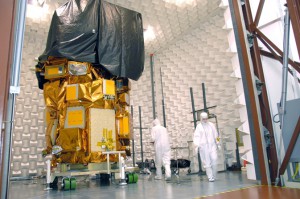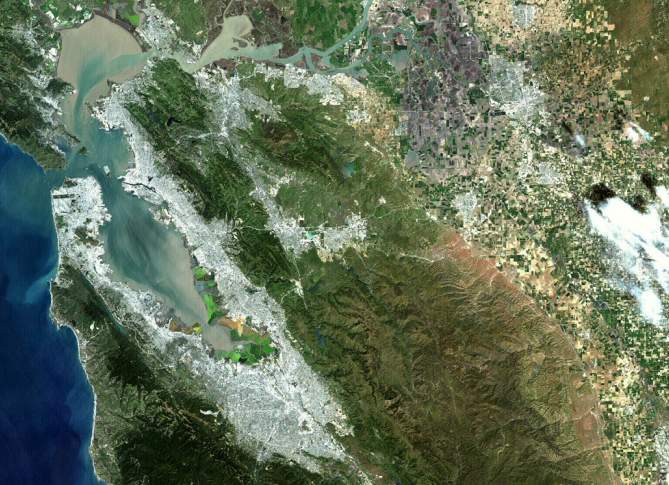
As of August 30, the Landsat Data Continuity Mission (LDCM) Observatory successfully completed Electromagnetic Interference/Electromagnetic Compatibility testing at Orbital Science Corporation’s facility in Gilbert, Arizona. It will next undergo a series of tests to validate that it can survive the launch environment. Photo Credit: Orbital Sciences Corporation
September 27, 2012 Vol. 5, Issue 9
Landsat Data Continuity Mission (LDCM) engineers overcame two obstacles to keep the mission on track for a launch readiness date of February 11, 2013.

As of August 30, the Landsat Data Continuity Mission (LDCM) Observatory successfully completed Electromagnetic Interference/Electromagnetic Compatibility testing at Orbital Science Corporation’s facility in Gilbert, Arizona. It will next undergo a series of tests to validate that it can survive the launch environment.
Photo Credit: Orbital Sciences Corporation
[Editors note: The following article is originally from Goddard Space Flight Centers Code 400 monthly newsletter. It appeared in the 2012 Summer/Fall Issue, Volume 20, Number 2, which can be accessed at: http://fpd.gsfc.nasa.gov/critical_path_12summerfall.pdf.]
The first problem occurred after the Thermal Infrared Sensor (TIRS) instrument was shipped from the Goddard Space Flight Center to Orbital Sciences Corporation, in Gilbert, Arizona in February 2012, when engineers discovered that helium had leaked from the TIRS cryogenic cooler. The cooler keeps the detectors extremely cold, which is important because the instrument detects thermal infrared radiation emitted from Earth. The leak was quickly repaired by the Ball Aerospace team from Boulder, Colorado that built the cooler; the cooler was then re-pressurized with helium, and TIRS was successfully re-installed onto the instrument deck of the spacecraft.
The second obstacle was in early April of this year when the spacecraft experienced a power short anomaly during integration and test of the flight battery. After an investigation, engineers discovered the anomaly caused some damage to components in three spacecraft electronic boxes. Orbital and Goddard worked on a recovery plan and the boxes have now been repaired and re-integrated onto the spacecraft.
“All flight projects encounter technical challenges during the development phases and LDCM has had its share,” said Ken Schwer, LDCM project manager at Goddard. “All challenges have been effectively addressed and none have yet caused irreparable setbacks in terms of performance or schedule.”
The engineering team at NASA’s Goddard Space Flight Center in Greenbelt, Md., built TIRS on an accelerated schedule, going from a design on paper to a completed instrument in a remarkable 43 months. An instrument of this complexity usually takes another year or more to complete.
Engineers at Orbital have integrated onto the spacecraft both the Goddard-built TIRS instrument and LDCM’s primary instrument, the Operational Land Imager (OLI) that was built by Ball Aerospace & Technologies Corporation. The next step for the satellite is environmental testing by Orbital.
LDCM is the eighth satellite in the Landsat series and continues the Landsat program’s critical role in monitoring, understanding and managing the resources needed for human sustainment such as food, water and forests. “As our population surpasses seven billion people, the impact of human society on the planet will increase,” said Jim Irons, LDCM project scientist at Goddard. “Landsat monitors those impacts as well as environmental changes.”
With the longest unbroken data stream of Earth’s surface as seen from space, the Earth-observing Landsat fleet has provided the world with unprecedented information on land cover changes and their residual effects since 1972. NASA GSFC managed the development and launch of the six successful Landsat satellites (Landsat 6 failed to achieve orbit in 1993 when launched under other management). The U.S. Geological survey currently operates Landsat 5 and Landsat 7 in orbit and will operate the LDCM following launch.
The knowledge gained from 40 years of continuous data contributes to research on climate, carbon cycle, ecosystems, water cycle, biogeochemistry and changes to Earth’s surface, as well as our understanding of visible human effects on land surfaces. Building off that research, the Landsat imaging data set has, over time, led to the improvement of human and biodiversity health, energy and water management, urban planning, disaster recovery and agriculture monitoring, all resulting in incalculable benefits to the U.S. and world economy.
LDCM will join the aging Landsat 5 and Landsat 7 satellites in orbit and continue to produce stunning images of Earth’s surface along with a wealth of scientific data. LDCM will measure Earth’s surfaces in the visible, near-infrared, short wave infrared and thermal infrared, with a moderate resolution of 15 to 100 meters, depending on spectral frequency. The OLI and TIRS instruments aboard LDCM will offer advancements with respect to refined spectral bandwidths, two new shortwave spectral bands, two thermal spectral bands rather than one, and improved radiometric performance. The ground system also offers greater capacity for capturing, archiving, processing and distributing data.
LDCM is a collaboration between NASA and USGS, and after launch will be renamed Landsat 8. Under contract to NASA, Orbital is responsible for providing the spacecraft bus, installing the science instruments and performing system-level integration and testing of the Observatory prior to launch, while Ball Aerospace built the OLI instrument. The USGS developed the LDCM ground system and is responsible for Landsat’s massive archive of more than three million images.
Rani Gran / Code 130
Public Affairs Specialist









